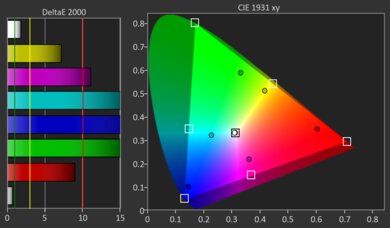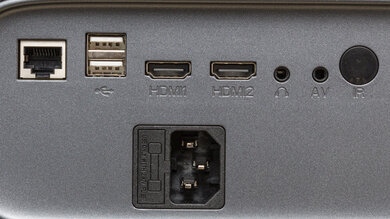The NexiGo PJ40 (Gen 3) is an entry-level home projector with a 1080p native resolution, and it sits above the cheaper NexiGo PJ20 but slightly below the more fully featured NexiGo PJ30 Ultra. It has Android TV built-in, Bluetooth 5.1, Wi-Fi, and full casting support. The projector also supports HDR10, has a low latency gaming mode, and an adjustable fan speed. It has two HDMI ports, one of which has ARC support, alongside two USB ports, an AV-in port, and a headphone jack, so you can play media from a USB flash drive or plug in various devices via HDMI or 3.5mm AV input. This model projects a 50-inch image from a distance of 4.7 feet up to a massive 300-inch image from a distance of 30.2 feet, and it comes with an integrated 20W speaker system.
Our Verdict
The NexiGo PJ40 is an acceptable choice for watching movies in a dark room. While it produces deep blacks, it's not bright enough to impress in moderately lit rooms, with noticeable vignetting in the corners. It also has a narrow color gamut with limited coverage of the Rec. 709 and Rec. 2020 color spaces. Furthermore, its colors are extremely inaccurate out of the box. Finally, it comes with a barebones implementation of Android TV without any streaming apps included; you need to cast your content to the projector or use a streaming dongle for the best experience.
-
Amazing contrast for deep blacks during darker scenes.
-
Full casting support with Miracast and AirPlay.
-
Poor brightness uniformity with noticeable vignetting.
-
Inadequate coverage of the Rec. 709 and Rec. 2020 color spaces.
-
Barebones Android TV implementation.
-
Very inaccurate out of the box.
- 6.3 Movies
Changelog
-
Updated Dec 06, 2024:
We've reviewed the projector's portability after taking into account how big the unit is, and we've updated the Portability text box accordingly.
-
Updated Nov 28, 2024:
We corrected a mistake in our Brightness measurements. The projector's color light output is now more in line with expectations.
-
Updated Nov 19, 2024:
We updated the Post-Calibration Color Accuracy text box after doing a full color calibration; the projector is now much more accurate after calibration than it was in our initial review.
- Updated Nov 13, 2024: Review published.
- Updated Nov 11, 2024: Early access published.
Check Price
Differences Between Sizes And Variants
The NexiGo PJ40 Gen 3 has no variants, but it is sold alongside two other products: the cheaper NexiGo PJ20 and the similarly-priced NexiGo PJ30 Ultra. The NexiGo PJ20 has a similar feature set to the PJ40 but is dimmer, doesn't have a low latency gaming mode, has no HDR support, and doesn't accept a 4k input. The NexiGo PJ30 Ultra is a slightly older product than the PJ40. Still, it has more features: it's rated to be a bit brighter, has full Auto Keystone functionality alongside autofocus, and comes with officially licensed streaming apps. However, it has the older Bluetooth 5.0, doesn't have a low-latency gaming mode, and can only project images of up to 200".
See our label.
Compared To Other Projectors
The NexiGo PJ40 is a mediocre projector, but it's bright for its price, and its contrast is amazing. There aren't many alternatives if you're shopping for something this cheap. The Epson EpiqVision Flex CO-W01 is generally a bit better than the NexiGo, but the Epson feels ancient in comparison due to its lack of any smart or wireless features. Otherwise, the XGIMI MoGo 2 is more easily carried around due to its small size and better smart OS implementation, but the NexiGo is the brighter of the two products and has vastly better contrast. Ultimately, the NexiGo PJ40 is not a bad purchase if you're looking for a projector this cheap.
Check out our recommendations for the best cheap projectors and the best home projectors. If you'd prefer to shop solely for another product in the same price range, look up the best projectors under $500 instead.
The NexiGo PJ40 (Gen 3) is better than the WiMiUS P63. The NexiGo is brighter, with much better contrast than the WiMiUS. While neither projector is colorful or accurate, the NexiGo is still the most colorful and accurate of the two. The one advantage of the WiMiUS is that it comes with a fully functioning Android TV implementation, while NexiGo's barebones implementation requires a streaming dongle to access any streaming apps. Otherwise, the NexiGo is clearly superior.
The Epson EpiqVision Flex CO-W01 is better than the NexiGo PJ40 (Gen 3), but they're quite different. The Epson is far brighter than the NexiGo, but its contrast is significantly worse. Thankfully, the Epson is also more colorful and is much more accurate out of the box. Unfortunately, the Epson's feature set is limited, as it doesn't come with any wireless or smart features, and it projects images in a 1280 x 800 resolution, which isn't optimal for content consumption. Ultimately, while the Epson is the better product, it also feels ancient compared to the more modern NexiGo.
The XGIMI MoGo 2 and NexiGo PJ40 (Gen 3) have slightly different usages. The XGIMI is a fully portable projector, as it's small enough to be carried around. The NexiGo is bigger and meant for use within the home. The NexiGo is the brighter projector of the two and has much better contrast. The XGIMI has a fully functioning Android TV implementation, while the NexiGo requires a streaming dongle to access any streaming apps. Ultimately, the NexiGo is the better option if you're looking for something to use in your home, while the XGIMI is the better option to carry with you.
The NexiGo PJ40 (Gen 3) is a bit better than the Samsung The Freestyle 2nd Gen, but they have different strengths and weaknesses. The NexiGo is noticeably brighter and has vastly better contrast. The Samsung projector is noticeably more colorful and is much more accurate overall. Still, it's not quite bright enough to take advantage of its color gamut. The Samsung is also much smaller and can be swiveled on its stand. It also comes with a fully featured version of Tizen, while the NexiGo has a barebones Android TV implementation without any streaming apps. Ultimately, the NexiGo offers better image quality, but the Samsung is the more versatile of the two products.
Test Results
The NexiGo PJ40's portability is acceptable. It's relatively lightweight but is bigger than other comparable products, like the Epson EpiqVision Mini EF12 or WiMiUS P63. You also need to plug it in since it lacks an internal battery. It has auto keystone adjustment but only on the vertical axis, so you must manually adjust the screen geometry when moving the projector left or right.
It doesn't have optical autofocus, but you can adjust the screen size digitally in the projector's settings. It also has an adjustable central front foot that you can use to help raise or lower the projector. Finally, it has an integrated 20W speaker system.
The NexiGo PJ40 Gen 3 has a native 1080p resolution but can accept signals of up to 4k resolution. It uses an LCD panel with an LED backlight, so you'll likely never need to replace it.
The NexiGo PJ40 projector has inadequate brightness overall. That said, it's quite bright for a projector at this price point, although not quite bright enough to be used in a room with ambient light, so it's best suited for a dark room. Its uniformity is also poor overall, as the corners of the image are noticeably dimmer than the center.
The projector has excellent contrast and performs exceptionally well in darker scenes, leading to deep blacks when watching content in a dark room. Its relative contrast performance drops as the scenes get brighter, but it's still very good overall.
This projector has poor pre-calibration image accuracy. Reds are severely underrepresented in all shades of white, although less so in near-blacks and in the brightest whites. Still, this results in a very cold color temperature that's far from our calibration target of 6,500K. When it comes to gamma, darker scenes and very bright scenes are both too dark, especially for the latter. Finally, there are noticeable color mapping issues with all colors, with saturated purples and blues having an excessive amount of them.
The projector's image accuracy after calibration is great. White balance is now fantastic, with only very bright whites still showing some minor accuracy issues. The color temperature is almost exactly on our 6,500K target, and the gamma shows no noticeable deviations from what it should be. Color accuracy is also greatly improved, as it's now alright overall. However, blues still have significant color mapping issues, and most colors deviate slightly from what they should be.
One thing to note is that changing the fan speeds impacts the projector's image accuracy. Lower fan speeds result in slightly worse performance, but it's subtle.
The projector's color gamut is inadequate. It doesn't display the full range of colors in SDR content, and colors are displayed incorrectly, especially purples and blues. Its coverage of the wider Rec. 2020 color space is limited and is significantly inaccurate across the board.
The NexiGo PJ40 has Android TV built-in and supports Miracast and AirPlay for casting. It also has an integrated 20W speaker system.
The Android TV implementation on this projector is barebones and doesn't include any streaming apps; we recommend a streaming dongle for the best overall experience.
Comments
NexiGo PJ40 (Gen 3): Main Discussion
Let us know why you want us to review the product here, or encourage others to vote for this product.
- 21010
Hello! Unfortunately, we don’t provide our projector calibration settings at the moment. In any case, it’s highly unlikely our setting would help you. Each unit can differ significantly from another one, and calibration is extremely sensitive to the room the projector is in—everything from room lighting to even what you’re wearing during calibration makes a noticeable difference. Even on TVs we often tell users to not use our settings, as they’re there for reference only.
Hope that in the next few months you can release a basic how to article on projector calibration. Let us know!
- 21010
Where can I find the exact settings you guys used ? For the post calibration I don’t see it around that area
Hello! Unfortunately, we don’t provide our projector calibration settings at the moment. In any case, it’s highly unlikely our setting would help you. Each unit can differ significantly from another one, and calibration is extremely sensitive to the room the projector is in—everything from room lighting to even what you’re wearing during calibration makes a noticeable difference. Even on TVs we often tell users to not use our settings, as they’re there for reference only.
- 21010
Where can I find the exact settings you guys used ? For the post calibration I don’t see it around that area
Update: We’ve reviewed the projector’s portability after taking into account how big the unit is, and we’ve updated the Portability text box accordingly.
Update: We corrected a mistake in our Brightness measurements. The projector’s color light output is now more in line with expectations.
























